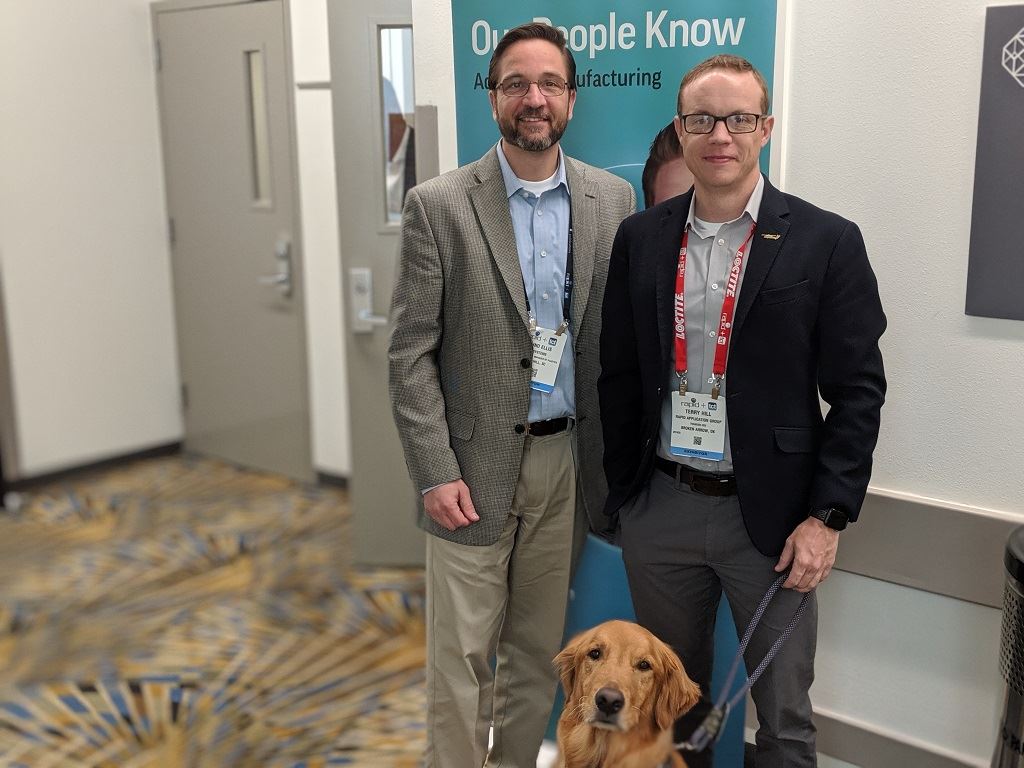![3D Systems’ Menno Ellis (left) with RAG’s Terry Hill and his excellent companion [Image: Fabbaloo]](https://fabbaloo.com/wp-content/uploads/2020/05/3dsystemsrag1_img_5eb0958304b66.jpg)
3D Systems’ Figure 4 system is up and running at Rapid Application Group.
Rapid Application Group (RAG), established in 2017, is the only disabled veteran-owned 3D printing company in the US, Founder and CEO Terry Hill told me recently when we caught up for a chat. The Oklahoma-based company has been seeing steady growth over the last few years, now running six machines with six employees — “and growing.”
“We didn’t have room for a large SLA system, and the Figure 4 is perfect for what we needed,” Hill said.
The company operates a standalone Figure 4 system that Hill calls their “workhorse,” along with two SLS systems, as well as FDM, DLP, and DMLS machines.
As we sat down with Menno Ellis, 3D Systems’ Senior Vice President and General Manager of Plastics, we mostly chatted about the place of the Figure 4. This system has been intriguing for a variety of reasons, as its debut was not exactly quiet but was metered out.
The Figure 4 system is designed to be modular, offering as many printers as necessary for an installation in an automated setup. RAG puts their standalone Figure 4 to use in creating “small, highly detailed production parts.”
“It has been mission-critical to the success of our company,” Hill said.
His team was running a 2,400-piece order, with another similarly-sized order queued up behind it, while we spoke. RAG’s customers have had the Figure 4 in demand for applications in defense and healthcare applications, as it has proven its quality.
“We threw a 3D printed piece across the room and it stuck in the sheetrock. That landed us a major contract,” Hill said.
Figure 4 Installation And Use
![A modular Figure 4 setup seen at IMTS 2018 [Image: Fabbaloo]](https://fabbaloo.com/wp-content/uploads/2020/05/3ds011_img_5eb09583610c9.jpg)
So far the adjustment to having the Figure 4 in-house has involved getting used to a new workflow, as with any new installation — but this time it was mostly in that workflow was so much speedier. The team was so accustomed to the 24-hour cycle of SLS 3D printing, Hill noted, that they would “almost forget about the Figure 4, going over and saying, ‘dang it, it’s done again’ to get the next job going.”
For 3D Systems’ side, the installation at RAG has proven useful as well: “It just makes sense,” Ellis said.
“We’re commercially ramping up in a way that makes sense for our customers,” he said. “The attributes on the Figure 4 that Terry sees are what we had in mind. For an order of 2,400 parts, will part 1 look like part 2,400? …The kind of business he’s running is exactly what this machine was designed for.”
The accessibility of the Figure 4 in terms of its modularity; the standalone system uses a standard (US) 110 plug, ethernet cable, and “you can change out materials quickly, within literal seconds, and not make a mess,” as Hill explains of operations.
Those materials remain a key part of 3D Systems’ strategic focus, as well, of course.
“The Figure 4 has production-grade materials, which can mean different things to different people, depending on their application. We often see tough materials. We are 100% solutions-oriented going forward,” Ellis said. “There are opportunities in casting, and with flexible, soft materials. We also have a to-be-released high-temperature material that right now hasn’t been possible with SLA.”
Additive Manufacturing In Business
3D Systems remains dedicated to its full ecosystem of offerings: materials, hardware, and software. For the best opportunities and results, all of these areas need to work in concert.
“There was a time in this industry when cool hardware was enough to sell; not anymore. You need materials, and software needs to give the best experience with that,” Ellis said.
“In a production environment, we look to areas where we play nicely with the software out there, so it doesn’t cause a customer to feel they need to make a choice when they have something they like. We’re taking a solution view for our customers rather than try to promote any one product at a time.”
Those solutions seem to be hitting the mark for RAG. Hill has before emphasized that “additive manufacturing is critical to those who have an open mind to adopt the technology.” RAG also works to train veterans across the “full gamut” of additive manufacturing, from design to yield, post-processing, and inspection. He noted that “It’s an easy transition for veterans working with tanks one day to AM the next” as these skills continue to emerge as workforce opportunities.
3D Systems
During our sit-down, I also couldn’t pass up the opportunity to check in on 3D Systems itself.
The company’s Q1 2019 results were not what they would have hoped, and stock prices dropped notably.
“There are macro things happening to us and to others; some quarters will be different,” Ellis said.
“Our strategy is that solutions will be geared to be full solutions for industry, addressing real problems. There’s a picture of the future that industry hasn’t fully tapped into yet, and as a company we want to help people think on the broader side of what can be done and talk to those commercializing. Continuous learning goes back and forth. We have to be very strategic in introducing solutions.”
He noted that among specific uses, “dental is picking up traction,” which certainly seems to be a case across the broader 3D printing industry.
The company may have its troubles, but there are customers fully satisfied with the solutions they’ve bought into, as RAG with the Figure 4 illustrates.
Via Rapid Application Group and 3D Systems











The debate over use of proprietary or open materials ecosystems is becoming a big topic in 3D printing.